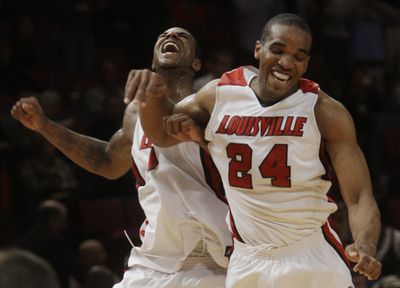Three top seeds from Big East
Louisville tabbed No. 1 overall

The Big East made history again. The conference that came together for basketball decades ago hit another milestone Sunday, when three of its teams earned top seeds in the NCAA tournament.
Louisville, Pittsburgh and Connecticut were all No. 1, joined by North Carolina of the Atlantic Coast Conference, never an outsider this time of year.
Still, the headlines on Selection Sunday belonged to the Big East, the league that gave us Patrick Ewing and John Thompson, one of the game’s biggest upsets (Villanova over Georgetown in 1985) and one of its greatest games (Syracuse over UConn in six overtimes Thursday).
The conference also broke new ground in 1985, when it became the first to place three teams in the Final Four.
“It speaks volumes for what it means to win the Big East,” said Louisville coach Rick Pitino, whose Cardinals are the tournament’s overall top seed and will play in the Midwest.
The Cardinals (28-5), winners of the regular-season and conference championships in the nation’s top-ranked conference, will open against the winner of an opening-round game Tuesday between Alabama State and Morehead State.
The rest of the tournament starts Thursday and Friday.
The Final Four is scheduled for Ford Field in Detroit on April 4 and 6. Last year, all four No. 1 teams made it to the Final Four. But Pitt (East), Carolina (South) and UConn (West) all know its called March Madness for a reason – things rarely go to form.
So, time to break out the brackets, sharpen some pencils and pay into an office pool (or two).
Maybe do a little griping here and there.
Among the aggrieved: Duke and Memphis, both overlooked in the quest for top seeding, settling for No. 2 seeds despite winning their conference tournaments. Memphis is often downgraded for playing in the less-than-steller Conference USA, but John Calipari’s team proved people wrong last year, making it to the national title game.
“I know people in the city are mad,” he said. “That’s OK. Good karma, good will.”
Penn State, San Diego State and Saint Mary’s were among those left out despite some impressive credentials. Saint Mary’s went 26-6 but lost by 25 to Gonzaga in its conference tournament final.
“I was hoping common sense prevailed,” coach Randy Bennett said. “Using common sense, we’re one of the top 34 (at-large) teams. This was the best team we’ve ever had, so it’s just disappointing to be in this situation.”
Feeling much differently was Arizona, which extended its NCAA-leading streak of tournament appearances to 25. But this one might be the most hotly debated. The Wildcats finished 19-13 and were all but written off after a first-round loss in the Pac-10 tournament.
“They beat UCLA, they beat Gonzaga, they beat us,” said Washington coach Lorenzo Romar, whose team won the Pac-10 regular-season title. “I think people missed the boat on our conference this year. The selection committee understood the Pac-10 is better than people thought.”
Thrilled as Arizona was, maybe nobody got a bigger kick out of hearing their names called than the North Dakota State Bisons. New players on the Division I level, the ND State seniors all committed to a redshirt year when they arrived, knowing this would be the first year they’d be eligible for the tournament.
The Big East also tied for the lead with seven teams in the tournament, along with the ACC and Big Ten.
Among the last teams to make it were Wisconsin, a 12th seed in the East; Maryland, a surprisingly high 10th seed in the Midwest; and Dayton, one of only four teams from small conferences to earn an at-large bid.
The so-called mid-major conferences have gone from nine at-large bids in 2005 to four this year. Besides Saint Mary’s, Creighton got left out, as did New Mexico, UNLV and San Diego State, all from the Mountain West.
Also absent will be Indiana and Kentucky – the first time both traditional powerhouses have been missing in the tournament since 1979.